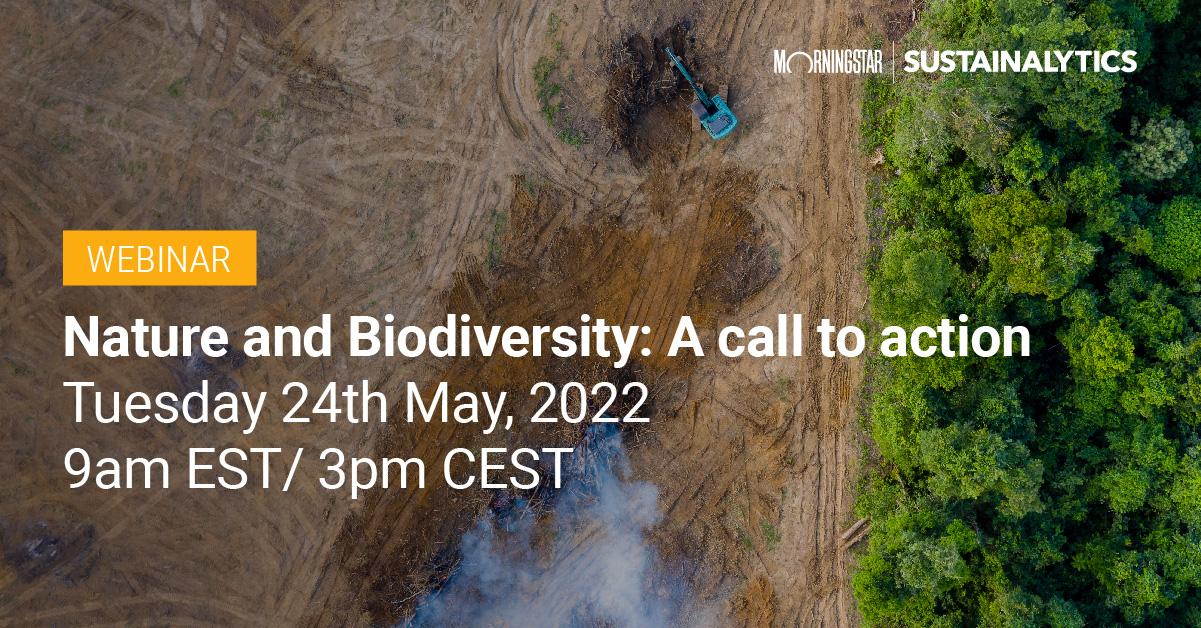Biodiversity loss and climate change call for a nature-positive economy – Stewardship may lead the way
The decline of biodiversity is accelerating at an alarming rate for the global economy, which is highly dependent on biodiversity and natural capital. More than half of the world's GDP, equal to $44 trillion USD, is moderately or highly dependent on nature.i Given the importance of biodiversity in supporting healthy and resilient ecosystems, a continued decline will leave society increasingly exposed to the impacts of climate change.
In the United Kingdom alone, more than 1,500 species of insects enhance food production and support healthy ecosystems.ii Similarly, 75% of global crop production benefits from pollinators and five to eight per cent are pollinator-dependent – the latter being equal to an annual market value of $235-577billion USD.iii

Forest ecosystems are highly diverse, holding 80% of the earth’s land-based biodiversity, including 73,300 different tree species. Every year, these forests absorb 2.6 billion tons of carbon dioxide, equal to 30% of CO2 released from the burning of fossil fuels.v Halting deforestation and promoting restorative actions is not only necessary to protect biodiversity, but it can also contribute to one-third of the necessary climate mitigation to meet the Paris Agreement.
Agrobiodiversity, an essential aspect of biodiversity, is the diversity of our food systems, including crops and animals. Out of the 6,500 plant species that have been cultivated for food in human history, only 170 are commercially significant today, and just 30 of these provide us with our daily energy and nutrient needs.vi With climate change, increasing water stress, and biodiversity loss, our current food systems are increasingly vulnerable to crop failure, thereby increasing food insecurity and risking economic instability.
Investors face increasing risk but also opportunities on a changing planet
The decline in biodiversity can cost the global economy upwards of USD 2,7 trillion per year by 2030.vii Consequently, biodiversity loss is in the top three global risks to businesses over the coming decade, together with climate action failure and extreme weather.viii
Financial institutions funding the supply chains affected by biodiversity loss stand to lose right alongside farmers, producers and retailers—and so, in turn, do investors.
This year, world leaders are expected to agree on a global goal for nature coined the Post-2020 Biodiversity Framework. The ambition is to put biodiversity on a path of recovery by 2030. By mid-century, biodiversity should be “valued, conserved, restored and wisely used, maintaining ecosystem services, sustaining a healthy planet and delivering benefits essential for all people.”ix
Transitioning to a nature-positive economy necessitates societal actors, including businesses, investors, NGOs and governments, to take large scale actions to improve the state of nature and boost nature’s contribution to society and the economy.
For investors, stewardship continues to be a powerful instrument to mitigate risks on a changing planet. With growing expectations of double materiality, it is an opportunity for investors to have a greater societal impact and support the transition towards a nature-positive economy. Doing so will enable investors to minimize risk while capitalizing on the opportunities associated with eco-conscious consumers, new technologies and innovative business models.
Sustainalytics’ Stewardship Team actively support our investor clients by engaging with companies on material ESG topics. In the scope of climate and biodiversity, we have several ongoing Thematic Engagement Programs, including Localized Water Management, Feeding the Future, Climate Change – Sustainable Forests and Finance, and Responsible Cleantech.
Introducing the Biodiversity and Natural Capital impact engagement
The systemic challenges posed by biodiversity loss require equally systemic solutions. In response to growing investor and societal needs, we have worked long and hard to rethink how thematic engagements can have a greater impact. In close collaboration with our clients and external stakeholders, we have developed a new stewardship program that will support industries transitioning to a nature-positive economy.
The Biodiversity and Natural Capital impact engagement employs a holistic value-chain approach to address the environmental challenges that are most material to investors today. Doing so, embraces the complexity and interlinkages of biodiversity and climate, land use, pollution, and water, rather than addressing these challenges in a vacuum.
The program is founded on a Theory of Change that envisions a global economy that does not harm nature but instead promotes nature-positive impact. To realize this vision, we have identified a set of expected outcomes to guide our engagement with companies. At the core, we will focus on governance and stakeholder engagement to ensure that material risks and opportunities are addressed at the board level.
Initially, the program targets 50 multinational companies (MNCs) in the agricultural value chain— from financiers and retailers to traders, agrochemicals, and producers. From ENCORE, it is evident that agriculture has a high impact and dependency on nature. This warrants engagement on the impacts and opportunities related to our food systems. As the program progresses, the scope of the engagement will evaluate the inclusion of other industries or topics depending on investor needs.
Local farmers produce almost a third of all the food we eat, and they do so by only using a quarter of global agricultural land. The diversity of farmers presents unique opportunities and challenges to companies wishing to promote regenerative agriculture in their supply chains. The program, therefore, has special attention to how companies may empower local farmers to transition into regenerative agriculture while increasing resilience and food security through increased agrobiodiversity.
In our conversations, investors and stakeholders have expressed the need for alignment with best-practice standards and frameworks while ensuring that the program does not overlap with similar initiatives. Correspondingly, the program will align with the Taskforce for Nature-related Financial Disclosures and the Science-Based Target Network. We also wish to support investor alliances, such as CA100, Net-Zero Asset Owner Alliance and the upcoming NA100, when engaging the same issuers and by aligning outcomes to meet the targets of participating investors.
The Biodiversity and Natural Capital impact engagement expands the traditional scope of engagements to include diverse stakeholders, such as policymakers, intergovernmental organizations, and NGOs, thereby leveraging synergies and generating systemic impact. By doing so, investors will leverage their shareholder position to support the transition toward a nature-positive economy and align with the upcoming Post-2020 Biodiversity Framework.
Given the importance of stakeholder consultation and alignment with established initiatives, Sustainalytics attended the TRADE Hub meeting in April 2022 to address the impacts of agricultural supply chains on biodiversity. The two-day meeting included keynotes from leading organizations such as the World Conservation Monitoring Centre (UNEP-WCMC), Cambridge Institute of Sustainability Leadership (CISL), Stockholm Environment Institute (SEI) and Google. During the planned breakout sessions, diverse actors shared their perspectives on how to address the impacts of agricultural supply chains on biodiversity, giving special attention to the tools and metrics available to companies, investors, and policymakers. The meeting provided valuable insights into what the future holds for biodiversity in an ESG context, which has been included in the Biodiversity and Natural Capital impact engagement.
Get in touch to learn more about the Biodiversity and Natural Capital impact engagement, the brochure is available here.
Join us on May 24 for a webinar hosted by biodiversity experts at Sustainalytics to learn more about what investor stakeholders are considering to address nature loss. Register here.
























